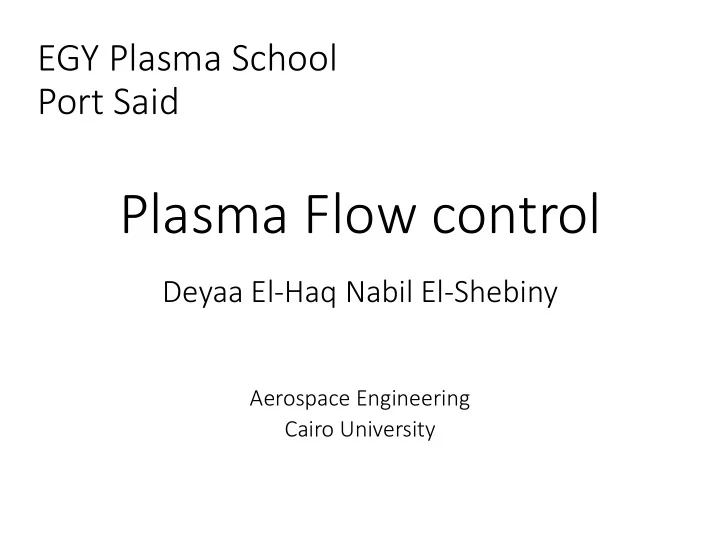

EGY Plasma School Port Said Plasma Flow control Deyaa El-Haq Nabil El-Shebiny Aerospace Engineering Cairo University
Abstract • Aerodynamic plasma actuators supplied by a dielectric barrier discharge (DBD) can used for active flow control • Usually, sinusoidal voltages in the range 5 – 50 kV peak and frequencies between 1 and 100 kHz are utilized to ignite this plasma typology. • The surface discharge produced by these devices is able to accelerate the flow field by means of electro- hydrodynamic (EHD) interaction, can induce speeds up to 10 m/s. • Their use over airfoils, flaps, and blades have shown the possibility to prevent flow separation which enhance lift and reduce drag.
Airfoil Separation and Stall Lift coefficient varies with angle of attack. For efficient performance, It should be as high as possible. Wind gusts cause separation and stall to occur if angle of attack increases past maximum levels.
Lift coefficient with flow angle of attack Adapted from http://www.sportpilot.org
Plasma Actuators لزاعلافوشكملا بطقلاىطغملا بطقلا ددرتملا رايتلا ردصم
DBD Actuator Physics Plasma aerodynamic actuators are based on the electro- hydrodynamic (EHD) interaction. Appling High electric fields can locally ionize the air. The produced heavy-charged are accelerated by the applied electric field and by means of collisions, they can yield momentum to the surrounding air. The induced airflow , called ‘ Ionic Wind ’ results Plasma induced airflow and response force Adapted from Cheong et al. 2010
Massless Wall Jets • DBD actuators modify fluid flow characteristics by generating massless wall jets in the boundary layer of the flow • Introduction of these jets injects momentum into the boundary layers to delay separation or even reattaching separated flow
DBD Actuators for Flow Separation
References • Mei Cheong and Maziar Arjomandi, “ Current Trends in the Application of Atmospheric Plasma for the Improvement of Wind Turbine Efficiency through Separation Control ” , University of ADELAIDE. • S. Kiel Hockett Jr. and Kyle Higdon, “ Plasma Actuators as Active Flow Control on Wind Turbine Blades ” , University of Notre Dame. • Gabriele Neretti, “ Active Flow Control by Using Plasma Actuators ” , INTECH-chapter 3, http://dx.doi.org/10.5772/62720 • Dmitry F. Opaits, “ Dielectric Barrier Discharge Plasma Actuator for Flow Control ” , NASA/CR — 2012-217655 Final Report, Princeton University.
Recommend
More recommend